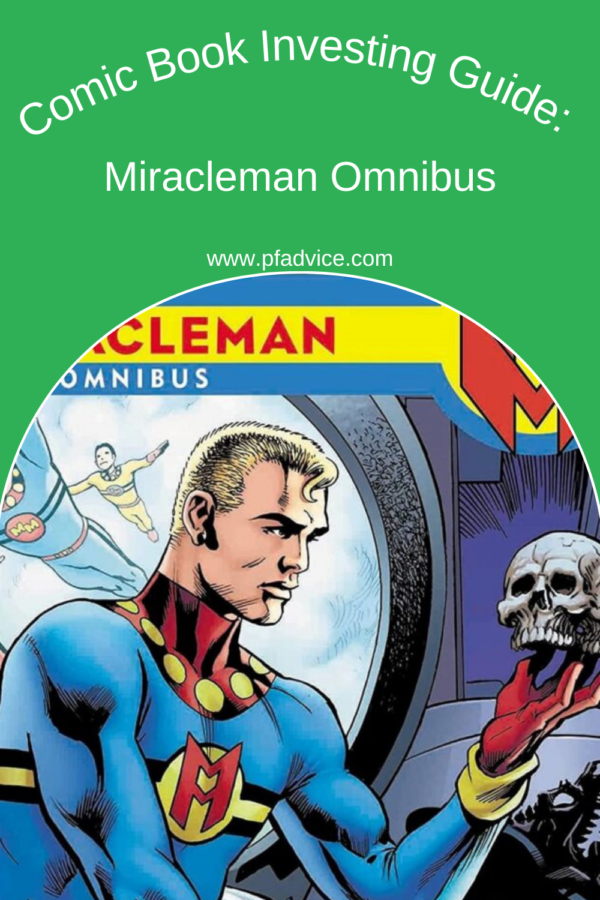Comic Book Investing Guide: Miracleman Omnibus

It’s kind of my bag to give casual comic book readers a bit of grief. It’s kind of like if you like a local band, then they blow up internationally, and suddenly everyone is a fan. I was a comic book fan pre-2007 when comic book fans were considered dorks and uncool. And now we’re full circle. But I’m going to give casual fans a break. If you loved comic book films like Watchmen, V For Vendetta, From Hell, and the animated version of Batman: The Killing Joke, then you are an entry-level comic book fan of iconic writer Alan Moore. And you may absolutely love Miracleman Omnibus.
- Miracleman Omnibus (October 2022)
- Published by Marvel Comics
- Writer: The Original Writer, Mick Anglo, Cat Yronwode, Grant Morrison, and Peter Milligan
- Artists: Alan Davis, Garry Leach, Kevin Nowlan, John Totleben, Rick Veitch, Chuck Austen, John Ridgway, Don Lawrence, Steve Dillon, Paul Neary, Rick Bryant, Joe Quesada, and Mike Allred
- Hardcover Price: $100 USD
Alan Moore is a heralded English writer and novelist who is known for revitalizing and modernizing the comic book industry as we know it in the early 1980s. He wasn’t the only one of course – Frank Miller did the same in the 1980s.
Moore is almost 70 now, a recluse, and kind of curmudgeonly. After weathering bad contracts and deals with corporate comic book companies, he refuses to allow his name to appear on new editions of his old works. Moore is credited as “The Original Writer,” in the new omnibus edition of Miracleman printed by Marvel.
But hardcore comic book writers know who “The Original Writer,” is. If you saw any of the previously mentioned films, you knew his work without knowing it.
Comic books are divided into eras called “ages.” Superman sparked the “Golden Age,” during WWII. Comic books were still simple by the Silver Age and heavily censored. The Bronze Age saw comics grow up a little, mirroring the struggles of the real world and not just simplistic stories of good and evil.
But the Modern Age of comic books, which started in the early 1980s, dared to show superheroes as flawed, as human beings with superpowers who still possessed the flaws, emotional limitations, and hubris of ordinary humans. Modern Age superheroes did not just save a cat from a tree, smile, and fly away as Superman did in the Golden Age.
In 1982, when Moore was 27, he wrote Miracleman for a British publication and heralded a paradigm shift in the comic book landscape. His characters showed the horrifying ramifications of superheroes existing in the “real world,” a world like ours, and comics have never been the same. Antiheroes probably only exist partially because of Moore’s early work.
Miracleman Omnibus is $100. Yes, it is a steep price, but I highly recommend that you get it for the complete collected reading experience of this comic. And then I recommend that you buy the individual issues of the series because there is a huge collectors market for them.
First Appearance of Miracleman
Marvelman #25 (1954) Fawcett comics; Moore Era starts in Warrior #1 (March 1982) Quality Communications
Miracleman Omnibus Required Reading (If You Like)
Every important issue of the 1980s version of Miracleman is included in Miracleman Omnibus. It’s about 40 issues spanning from 1982 to 2014.
Brief Bio and History – Miracleman Omnibus
It took over 30 years for the Miracle Omnibus to get printed. A new issue of Miracleman penned by Neil Gaiman, which was supposed to be printed 30 years ago, was just printed as well.
It’s a very long story, but it was due to decades spanning corporate lawsuits. Miracleman was known as Marvelman in the 1950s and 1960s before the original publisher closed down. There are hundreds of weekly Marvelman and Marvelman Family comics that were published during this time, the Silver Age of comics.
In the 1960s, Atlas Comics became Marvel Comics. In the 1980s, when the publishers of Marvelman tried to publish the series in the United States they changed the name to Marvelman to avoid legal conflicts.
The legal wrangling even involved Neil Gaiman and Todd McFarlane as both creators claimed to own Miracleman for many years. But that is the aggressively abbreviated version of events.
Marvel comics now owns the exclusive rights to Miracleman.
Miracleman Omnibus – The Review
Miracleman Omnibus collects the 1980s saga of Miracleman as reimagined by a young Alan Moore. It’s the story of a middle-aged and unambitious reporter named Michael Moran.
Moran is having reoccurring nightmares about flying, vague codewords and witnessing others dying in atomic flashes and explosions. His wife is concerned about his deteriorating mental state, non-ambitious life, and their future.
As Moran goes to a report on a demonstration against atomic energy, the crowd is taken captive by terrorists. Moran, gripped by fear and adrenaline, remembers the vague codeword and transforms into Miracleman. He is now half his age and as strong as Superman.
Miracleman saves the day and returns to his incredulous wife who can’t believe what happened. Moore has deftly crafted a narrative where Moran had amnesia for almost 20 years, which is when the last adventures of Marvelman were published in the 1960s. It was a much simpler time, where good and evil were black and white and superheroes saved cats from trees.
Moran’s true powers are reawakened in the 1980s. It is an era of moral decay, and societal indifference; a place where you could always have the last word if you wielded enough power.
Believe me, I am not spoiling the story. I barely described the start of it. The first issue is a fake out, a nod to the previous history of the character, which I glossed over.
Miracleman would slowly go on to realize that he was so powerful that he could go on to do whatever he wanted to do. Have you ever heard the phrase “society needs saving from itself?” Miracleman goes on to save the world from itself on his own terms without asking society’s permission in the manner of an omnipotent ant farm owner.
The story is not perfect. Moore’s writing is overly florid and descriptive at times. I love the artwork, but many critics have said that it is mediocre.
But it is a landmark storyline that showed how terrifying a superpowered human would probably act in the real world.
Have you ever considered that Superman must control every aspect of his physiology to pass as a human? He could crush your bones to dust. He could knock down a building by sneezing. Why would he want to be human or be respected as a human on a planet where power is everything?
Someone who holds a gun on you has as much power as Superman to compel you to do something against your will. If Superman existed, why would he be any different? Wouldn’t he be feared?
Even if Superman wanted to save the world, he might have to do it in a way that humanity would not agree with or appreciate. An anthill can’t stop you from stepping on it to make way for your picnic.
That is my interpretation of the characters in Miracleman Omnibus, and I think you should read it for yourself to experience it. It can’t be overemphasized that while such ideas in comics and pop culture are taken for granted very much today, these concepts were mind-blowing and unheard of in the early 1980s.
The antiheroes you love so much today exist partly because of this comic and the writings of Alan Moore.
Miracleman Omnibus – Buy It or NOPE
BUY IT NOW!
Yes, $100 is a steep price, but a worthwhile reading investment for a comic book of this importance. And since it takes money to make money, I recommend that you buy this omnibus to read and buy some of the individual issues as comic book collectible investments.
There is an aggressively faithful fanbase of Miracleman collectors who pay top dollar for old issues and old issues with variant covers.
This eBay seller is selling a pristine copy of Miracleman #1 for $384!
Miracleman #9, a landmark issue that depicted the birth of an infant sells for $40.
You can get several old Miracleman issues in the $10 to $70 range. And many are rather cheap. There were only 24 issues in the original Alan Moore run.
It probably won’t happen this decade (never say never) but Marvel could introduce a TV or cinematic version of Miracleman in the next decade or two. And then these back issue prices could skyrocket in value.
Read More
Comic Book Investing Guide: DC Vs Vampires #10
Comic Book Investing Guide: Avengers 1,000,000 B.C. #1
Comic Book Investing Guide: Edge of Spider-Verse #5

Allen Francis is a full-time writer, prolific comic book investor and author of The Casual’s Guide: Why You Should Get Into Comic Book Investing. Allen holds a BA degree from Marymount Manhattan College. Before becoming a writer Allen was an academic advisor, librarian, and college adjunct for many years. Allen is an advocate of best personal financial practices including saving and investing in your own small business.

